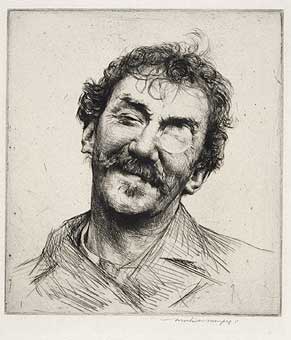Whistler to Freud

|
This extensive survey of British Etching begins with James Abbott McNeill Whistler and the Etching Revival of the second half of the 19th century. The exhibition traces the development of the art to the present day, focusing on groups of works by significant artists such as James Tissot, Walter Sickert, F.L. Griggs, Augustus John, Frank Auerbach and Lucian Freud.
Whistler to Freud: Etching in Great Britain features 100 works from the Art Gallery of New South Wales�s collection, and has been curated by Peter Raissis, Curator of European Prints, Drawings and Watercolours.
In his day Whistler�s reputation as a printmaker was second only to that of Rembrandt. With Francis Seymour Haden he led the British Etching Revival, extolling the expressive potential of the pure etched line and the importance of the original print as opposed to the reproduction. Both men fired the zeal for etching that lasted into the 1920s and 1930s. During this period the interest in etchings soared - a new breed of professional publishers and dealers sprang up, as did a flourishing industry of specialist journals and collectors� guides.
Among the etchers of this generation Walter Sickert stands out as the most innovative. He recorded the seamier side of contemporary life and scorned the predominant attitude to printmaking, inherited from Whistler, which claimed that each impression should be unique. Meanwhile, F.L. Griggs looked back with reverence to an ideal past. Miracles of technical achievement, his landscape and architectural etchings have an unworldly quality, evoking an imaginary British pastoral or medieval dreamland.
Following the Second World War, etching was superseded by other print techniques. During the 1960s and 1970s it suffered from the popularity of screenprinting, but significant printmakers such as David Hockney stayed loyal to the medium. More recently, etching has become the favoured graphic medium of artists like Frank Auerbach, Leon Kossoff and Lucian Freud. Freud�s etching after Chardin�s 18th-century masterpiece, The Young Schoolmistres, 2000 was generously presented to the Gallery last year by Margaret Olley. It is both the latest and the most up-to-date addition to the story of British Etching as it is told in the permanent collection of the Art Gallery of New South Wales.
|
| On view: | Art Gallery of New South Wales
Art Gallery Road
The Domain, Sydney 2000
Australia | | Telephone: | (02) 9225 1744 or recorded information
(02) 9225 1790
| | Hours: | 10am to 5pm 7 days a week
(closed Christmas Day and Easter Friday) | | Admission: | Free of Charge | | Media Information and Interviews: | Jan Batten
Press Office
telephone 61 2 9233 1213 or 0418 279 348
email janb@ag.nsw.gov.au | Mortimer Menpes
Portrait of Whistler, c.1890s
drypoint, 168 x 151mm (plate)
Collection Art Gallery of New South Wales
Anonymous gift, 1973
|
|